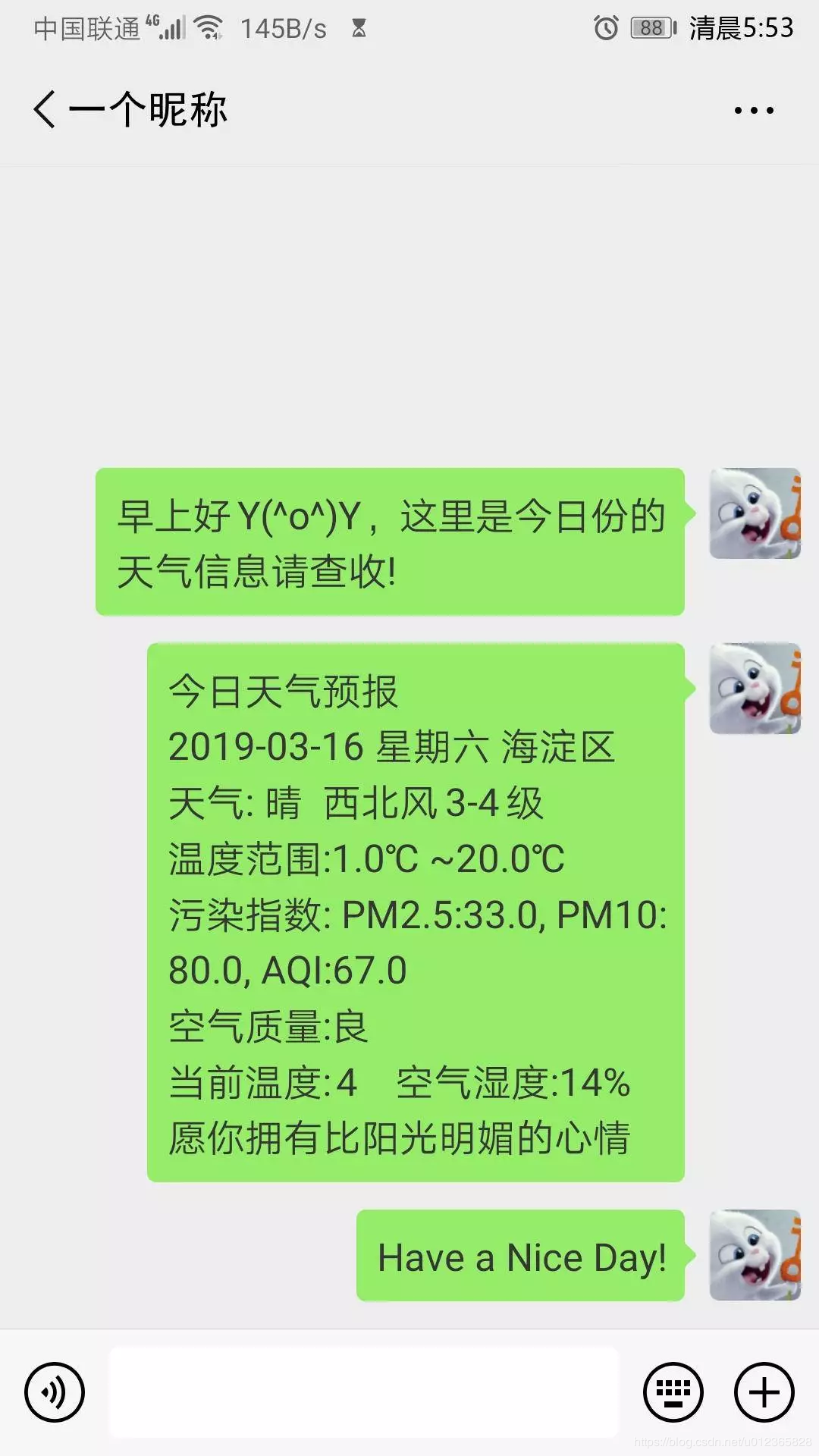这篇文章给大家分享的是有关怎么用python自制微信机器人定时发送天气预报的内容。小编觉得挺实用的,因此分享给大家做个参考,一起跟随小编过来看看吧。
python常用的库:1.requesuts;2.scrapy;3.pillow;4.twisted;5.numpy;6.matplotlib;7.pygama;8.ipyhton等。
0 引言
wxpy基于itchat,使用了 Web 微信的通讯协议,通过大量接口优化提升了模块的易用性,并进行丰富的功能扩展。实现了微信登录、收发消息、搜索好友、数据统计、微信公众号、微信好友、微信群基本信息获取等功能。
1 环境
操作系统:Windows / Linux
Python版本:3.7.2
2 代码实现
我们要实现用Python来发微信,发送的内容是每天最新的天气信息。很明显我们需要完成两部分的准备,先来看看获取天气信息这部分内容。
2.0 准备工作
本文我们用到的第三方库有requests、wxpyy,若环境还没有,按如下方式进行安装即可。
pip install wxpy
pip install requests
2.1 获取天气信息
这里我使用的API的请求链接如下:
http://t.weather.sojson.com/api/weather/city/city_code
请求方式是GET方法,使用时注意更换为自己城市对应的city_code,除此之外不用带任何参数。
请求是restfull风格,city_code为9位数字,如下示例:
{ "_id": 58, "id": 59, "pid": 3, "city_code": "101230201", "city_name": "厦门" }大家可以从_city.json文件中获取各个城市对应的编号。该文件我已经放在Github本文章对应的目录下了,大家可自行查询使用。
# weather API的URL,此处的城市编号,参看_city.json url = 'http://t.weather.sojson.com/api/weather/city/101010200' header = { 'User-Agent': 'Mozilla/5.0 (Windows NT 10.0; Win64; x64) AppleWebKit/537.36 (KHTML, like Gecko) Chrome/73.0.3683.75 Safari/537.36' } # 请求Weather API并拿到服务器返回的数据 rep = requests.get(url, headers = header) rep.encoding = "utf-8" result = '' weather = rep.tex这个API接口的返回值内容很多,以下仅展示返回的部分信息。实际使用中仅用到三块内容,首先是城市信息。
"cityInfo": { "city": "海淀区", //请求城市 "cityId": "101010200", //城市ID "parent": "北京市", //上级,一般是省份 "updateTime": "09:02" //天气更新时间 }其次是,该城市当前天气的空气相关指数。
"data": { "shidu": "32%", //湿度 "pm25": 35.0, //pm2.5 "pm10": 97.0, //pm10 "quality": "良", //空气质量 "wendu": "7", //温度 "ganmao": "极少数敏感人群应减少户外活动", //感冒提醒(指数) }第三部分,该城市当前天气的温度风力等另外一些指数。
"forecast": [ //今天+未来14天 { "date": "16", //日期 "sunrise": "06: 28", "high": "高温 20.0℃", "low": "低温 2.0℃", "sunset": "18: 21", "aqi": 48.0, "ymd": "2019-03-16", //年月日 "week": "星期六", "fx": "西北风", //风向 "fl": "3-4级", //风力 "type": "晴", "notice": "愿你拥有比阳光明媚的心情" } ]注:这个API接口返回值完整的示例,请见Github中本文章目录下的weather.json文件。
拿到返回值之后,需要解析,并转换组装成我们想要的格式。
# 解析服务器返回的数据,具体可参考weather.json文件 index_cityInfo = weather.find("cityInfo") index_cityId = weather.find("cityId") index_shidu = weather.find("shidu") index_pm25 = weather.find("pm25") index_pm10 = weather.find("pm10") index_quality = weather.find("quality") index_wendu = weather.find("wendu") index_ganmao = weather.find("ganmao") index_forecast = weather.find("forecast") index_ymd = weather.find("ymd", index_forecast) index_week = weather.find("week", index_forecast) index_sunset = weather.find("sunset", index_forecast) index_high = weather.find("high", index_forecast) index_low = weather.find("low", index_forecast) index_fx = weather.find("fx", index_forecast) index_fl = weather.find("fl", index_forecast) index_aqi = weather.find("aqi", index_forecast) index_type = weather.find("type", index_forecast) index_notice = weather.find("notice", index_forecast)这是我最终想达到的效果如下:
# 今日天气预报
# 年月日 + 星期 + 所在地城市
# 天气类型 + 风向 + 风力
# 温度范围(最低温度~最高温度)
# 污染指数:PM2.5/PM10/AQI
# 空气质量
# 当前温度 + 空气湿度
# Notice信息
转换化具体代码就是这样子的:
result = '今日天气预报' + '\n' \ + weather[index_ymd + 6:index_week - 3] + " " \ + weather[index_week + 7:index_fx - 3] + " " \ + weather[index_cityInfo + 19:index_cityId - 3] + '\n' \ + "天气: " + weather[index_type + 7:index_notice - 3] + " " \ + weather[index_fx + 5:index_fl - 3] \ + weather[index_fl + 5:index_type - 3] + '\n' \ + "温度范围:" + weather[index_low + 9:index_sunset - 3] + " ~" \ + weather[index_high + 10:index_low - 3] + '\n' \ + "污染指数: PM2.5:" + weather[index_pm25 + 6:index_pm10 - 1] + "" \ + "PM10:" + weather[index_pm10 + 6:index_quality - 1] + " " \ + "AQI:" + weather[index_aqi + 5:index_ymd - 2] + '\n' \ + "空气质量:" + weather[index_quality + 10:index_wendu - 3] + '\n' \ + "当前温度:" + weather[index_wendu + 8:index_ganmao - 3] + " " \ + "空气湿度:" + weather[index_shidu + 8:index_pm25 - 3] + '\n' \ + weather[index_notice + 9:weather.find('}', index_notice) - 1]这样我们的第一步,获取天气信息就完成了。接下来就是登录微信定时发送消息了。
2.2 登录微信定时发送消息
首先要登录微信,一行代码就搞定了。这里实际上是扫二维码登录了一个Web版的微信。
# 初始化机器人,扫码登陆微信,适用于Windows系统 bot = Bot() # Linux系统,执行登陆请调用下面的这句 bot = Bot(console_qr=2, cache_path="botoo.pkl")
然后我们需要定义一个发送消息的函数,将获取并解析好的天气信息发送给指定微信好友。
# 调用get_weather函数 GW = get_weather() # 填入你朋友的微信昵称,注意这里不是备注,也不是微信帐号 my_friend = bot.friends().search(u'一个昵称')[0] # 发送微信消息 my_friend.send(u"早上好Y(^o^)Y,这里是今日份的天气信息请查收!") my_friend.send(GW) my_friend.send(u"Have a Nice Day!") # 每隔86400秒(1天),发送1次 t = Timer(86400, auto_send) t.start()
接下来,你可以使用try...except...语句来实现在消息失败时发出告警:
try: '''此处为发送消息的代码,即上一段内容''' except: # 你的微信昵称,注意这里不是备注,也不是微信帐号 my_friend = bot.friends().search('&娴敲棋子&')[0] my_friend.send(u"报告老板,今日份的信息发送失败了!")最后运行主函数,调用发送消息的函数即可。
# 调用函数进行消息发送 auto_send()
3 效果展示
这是我清晨收到的微信消息截图,看上去还不错。没白忙活?

感谢各位的阅读!关于“怎么用python自制微信机器人定时发送天气预报”这篇文章就分享到这里了,希望以上内容可以对大家有一定的帮助,让大家可以学到更多知识,如果觉得文章不错,可以把它分享出去让更多的人看到吧!
免责声明:本站发布的内容(图片、视频和文字)以原创、转载和分享为主,文章观点不代表本网站立场,如果涉及侵权请联系站长邮箱:is@yisu.com进行举报,并提供相关证据,一经查实,将立刻删除涉嫌侵权内容。